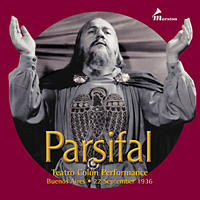
Parsifal
Teatro Colón, 1936
There is nothing like a live performance. A studio session can involve take after take until a recording is "perfect" yet may miss that indefinable magic that occurs only on stage. Opera enthusiasts can recall performances that were remarkable with vivid detail. They remember the cast, the date, who they were with, the set, the costumes and yet, without a recording, cannot share this experience. And the converse can hold true: listening to a recording of a remarkable live performance can transport the listener to a seat in a theater and make him believe he was in attendance. Few of us today were lucky enough to have a seat in the Colón on 22 September 1936 to hear Fritz Busch conduct René Maison (Parsifal), Marjorie Lawrence (Kundry), Alexander Kipnis (Gurnemanz) and Martial Singher (Amfortas) yet with this 3-CD set, you can.
A NOTE FROM WARD MARSTON
|
The 1936 Teatro Colón performance of Parsifal is undoubtedly the earliest complete recording of the opera. About twenty years ago, I first heard of this recording’s existence and eagerly awaited its eventual release on LP or later, on CD. As years passed, I heard nothing more about it and I assumed that either the recording had been lost or that it was so sonically inferior as to prevent its ever being released. Several years ago, however, I was given access to the original source discs and I am pleased to present here, for the first time, this fascinating performance of Wagner’s last music drama. During the Colón’s 1936–1937 season, four entire operas were recorded—Parsifal, Lohengrin, Der fliegende Holländer, and Der Rosenkavalier. No one seems to be certain as to exactly why the recordings were made and why other operas in that season were not transcribed. What is certain is that these four operas are the earliest recordings emanating from the stage of the great Teatro Colón. Turning our attention to Parsifal, I thought it advisable to explain how the recording was made and discuss some of its technical flaws. The performance was recorded on sixteen- inch, aluminum-based, lacquer-coated discs. Using two turntables running at approximately 32.8 rpm, the recording covers sixteen sides. I have been told that the recording equipment was located in the basement of the Colón and that three microphones were used, one above the orchestra, a second above the front of the stage, and a third over the rear of the stage. Unfortunately, the operator of this equipment did not know how to adjust the three microphones properly to achieve a comfortable balance between singers and orchestra. Throughout the performance, the engineer constantly changed the sound level and switched microphones on and off seemingly for no reason at all. The singers are, therefore, not always as audible as one would like them to be. Another flaw in the recording occurs during the change from one side to another. At these points, there is, for some reason, about a quarter second of missing music which makes it impossible to join the sides seamlessly. Finally, I should mention the presence of some radio interference during Act Two where one can hear two short bursts of dance band music. As occasionally happens, this was probably picked up by the cutting apparatus. In remastering this recording, my first task was to eliminate as much surface noise as possible without compromising the sound on the original discs. This was accomplished by carefully cleaning the discs and by wetting them while they were being played. I also found that using several different sizes of styli on different portions of the discs produced an enormous sonic improvement. I next attempted to remove many hundreds of clicks and pops which afflict this recording. CEDAR technology proved to be a tremendous help in this process but many pops still had to be removed manually using Sonic Solutions software. Some very large clicks were impossible to remove without affecting the integrity of the music. Finally, I attacked the problem of the erratic sound level changes during the performance. With careful editing, I was able to improve some of the most egregious examples. In many cases, however, the changes in balance were impossible to correct effectively. Despite these problems, the sound of the recording is quite good for the time and one does truly have the feeling of actually being in a seat at the Colón. Over the next two years, I plan to release the other three operas from that season beginning with a splendid performance of Der Rosenkavalier featuring Tiana Lemnitz, Editha Fleischer, Germaine Hoerner, and Alexander Kipnis. | ||